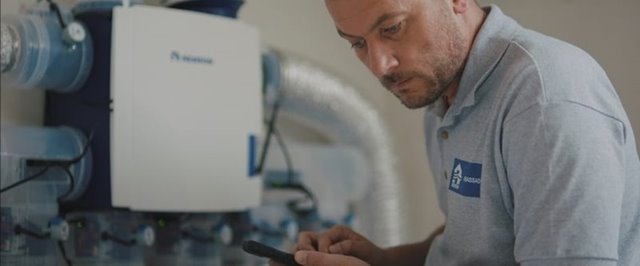Dust mite allergy? No thanks! Here's now to take the fight to the dust mite!
WHAT ARE DUST MITES?
Dust mites are tiny eight-legged arachnids that just love to hang out in fabrics around the house such as carpets, mattresses, bedsheets, curtains, and upholstered furniture. Consider them to be invisible little lodgers: even though it’s near impossible to see their 0.3 mm bodies with the naked eye, you can bet there are plenty of them lounging around your home too. What’s more: they only need three to four weeks to grow from an egg to an adult dust mite with a life expectancy of two to three months. To put it simply: dust mite populations expand at a rapid pace.
This particularly applies when they’ve found an environment that suits them down to the ground. Their favorite places to breed are dark spots with temperatures between 16 and 25° C and high air humidity levels in excess of 60%.

WHERE DOES DUST MITE ALLERGY COME FROM?
One thing should be clear by now: we’re all living cheek by jowl with these tiny critters. That said, many of us never give dust mites a second thought, even though we suddenly get a runny nose, start sneezing, get watery eyes, start coughing, get short of breath or start itching out of nothing. You guessed it: these are all symptoms consistent with a dust mite allergy. Even so, dust mites – who don’t bite and are happy to feed on skin flakes produced by humans and animals – don’t cause any allergies by themselves. The real culprit is to be found elsewhere: The excrement produced by dust mites!
Over the course of its short life, dust mites produce no less than 200 times their own body weight in excrement. These droppings are picked up as dust particles in the air, and we unwittingly breathe them in at night.
HOW DO YOU PREVENT DUST MITE ALLERGY?
Did you know that allergies were barely an issue until the 20th century? So what has changed in the meantime? Compared to days gone by, today’s homes are much better insulated. New-build homes are almost like an airtight box from which dirty air can’t escape and into which fresh air can barely enter. In other words: they’re the perfect breeding ground for these critters! It’s pretty unlikely that you’ll ever be completely cured from a dust mite allergy. One thing you can do, however, is significantly reduce the symptoms of your dust mite allergy by designing your environment in just the right way.
Completely banning these tiny critters from your home is deep in the realm of fantasy, but there are ways to fight the dust mite and significantly reduce the current population in your home. Ventilation is an absolute priority in doing so.

WHY IS VENTILATION SO IMPORTANT?
Dust mites are highly sensitive to changes in their living environment. Properly ventilating your living space will reduce the temperature and cause the humidity level to drop, and dust mites will struggle as a result. Once dust mites start feeling less comfortable in their surroundings, they’ll stop breeding so quickly. As a result, your battle plan against dust mites and dust mite allergy should be structured around two central tenets: keeping relative air humidity low and removing the places where they shelter. That’s why it’s a good idea to pull back your duvet in the morning so that your mattress and fitted sheet can get some fresh air too.
Simply letting some fresh air in by opening the window for fifteen minutes is nothing but a short-term solution. The best way to keep your bedroom healthy is to ventilate around the clock. And if you’d like to do so smartly, a mechanical ventilation system is the way to go!
WHAT’S THE DIFFERENCE BETWEEN LETTING FRESH AIR IN AND VENTILATION?
Letting fresh air in and ventilation are two concepts that are often confused with one another. There is a difference between the two: Letting fresh air in (as hinted at above) is a short-term solution in which you replace a large volume of air by opening windows, doors, or skylights. Ventilation, on the other hand, is the continuous replacement of indoor air via a ventilation system. So, which one of these two options offers the best way to protect all members of your family from dust mite allergies, asthma or eczema? It’s not a question of choosing between them: both solutions have a lot to offer! The only way to guarantee a healthy indoor climate is to combine them both.
By the way, did you know that letting fresh air in can actually contribute to mold in the home? The reason for this is that the large volume of cold outside air gives rise to too much of a contrast with the warm indoor air, causing condensation, and eventually, mold. As a consequence, a decent ventilation system is absolutely essential for good health.

WHICH TYPES OF VENTILATION SYSTEMS ARE AVAILABLE?

We’ve briefly touched on mechanical ventilation, the ultimate way to guarantee efficient air circulation in your living spaces around the clock. Take the fully automated, demand-driven, and energy efficient C+ ventilation system as an example. To ensure a natural supply of fresh air, this system uses self-regulating window vents. Extraction of dirty indoor air is handled via a central extraction unit, Healthbox 3.0, which adapts as the air quality in the home changes. Bladed walls are also a possibility, albeit one that’s mainly used in industrial or office settings.
If you’re seeking to ventilate effectively and make the most of renewable energy, an E+ ventilation system is exactly what you’re looking for! This intelligent system combines a continuous supply of fresh air via ventilation louvres with mechanical extraction of dirty air via a central extraction fan, plus an air/water heat pump to generate hot sanitary water.
WHAT ELSE CAN YOU DO TO FIGHT DUST MITES?
Choosing the right vacuum cleaner is another important factor in gaining the upper hand over dust mites, because most normal vacuum cleaners blow out air, which inevitably contains dust particles. Luckily, there are special vacuum cleaners with HEPA filters (high-efficiency particulate air filters): a filter that makes sure the air your vacuum cleaner blows out is clean. Another thing you can do is get rid of unnecessary fabrics. Replace your carpeting with a maintenance-friendly, anti-allergic option and try to find a healthier alternative to curtains. You should also open your dynamic sun protection roller shutters or screens so that sunlight can enter your bedroom.
Closed wardrobes and anti-allergic bedding can also make a world of difference to anyone suffering from a dust mite allergy. Or how about a selection of air-purifying plants to improve your indoor climate?
Sprays against dust mites are sometimes recommended, but their effect remains unproven. You should always take care using these kinds of substances in your bed; after all, you’ll be sleeping in it every night too.
WHO IS BEST PLACED TO HELP IN THE FIGHT AGAINST DUST MITES?
If you’re convinced that ventilation is the first step towards getting rid of dust mites and dust mite allergies but you’re not sure which ventilation system is the best fit for your home and your personal needs, Simply request a Renson® ventilation brochure or contact our ventilation specialists. Our dealers, Ambassadors and Premium Ambassadors are more than happy to listen to your requirements, provide advice tailored to your needs and help you get the upper hand over dust mites.
